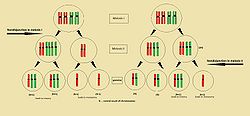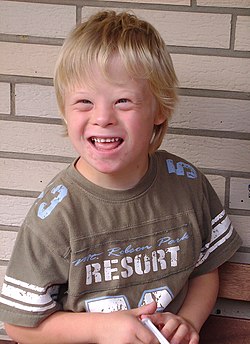Down Syndrome
Down syndrome is the best-known trisomy. It was described in 1866 for the first time by John Down[1], but the karyotype of 21 trisomy was discover much more later – in 1959 by prof. Jerome Lejeune [2]. The incidence of trisomy 21 is about 1 in 800 newborns. It is important to say that that´s just a small part of all the affected fetuses. Most of the fetuses with Down syndrome die because of the abortion.
The Origin of Trisomy 21[edit | edit source]
- the most common is an extra chromosome 21 (95%) (full trisomy);
- sometimes a small parts of chromosome 21 translocate to 14 or 22 chromosome (4%) (translocation variant);
- in some cases we can find mosaic – it means that person has some cells with trisomy and some without (2%) (mosaic variant).
The clinical significance of mosaic variant of the Down syndrome depends on the number of trisomic cells. However - it is very difficult to estimate the severity of the symptomps using the plain numbers, since the clinical significance also depends on the number of trisomic cells in specific body tissues, what is very difficult to diagnose. Basically - it is possible to say, that the full trisomy is significantly worse than the mosaic variant of the Down syndrome.
Symptomes[edit | edit source]
People with Down sy have typical physical appearance. They have short body, flat faces profile, epicanthic folds (part of skin over the inner corner of the eye – the reason why they are sometimes called "Mongoloid"), small low-set ears and relatively large tongue. They have also motor problems because of low muscle tone.
Carriers suffer more from leukemias, infections, cardiac malformations, epilepsy, hypothyroidism and Alzheimer disease.
The mental abilities are also worse. The IQ of people with Down syndrome is about 50. It means that they reach a level of a small child – about 6 years old. On the second side their character is very friendly, warm and loving.
The Cause of Trisomy 21[edit | edit source]
The cause of 21 trisomy is meiotic nondisjunction. Parents of the children have normal karyotype and no symptomes. Very strong influence has the age of the mother. The higher age is connected with higher risks (maternal age of 35 years and more is considered especially risky)[3]. The incidence is 1 in 25 live births in women older than 45 years. [4]
The role of the father´s age is less important. Just 4% of Down syndrome is caused by the mistake of meiosis in sperms. The reason is very simple. The evolution of sperm takes just 72 hours. It is the time when the meiosis underway. On the other side, ovum (female reproduction cell) is present in woman´s body from her birth. So the meiosis is underwaying for years and it is pretty easier to make a mistake. The higher age of the mother, the more meiosis, the higher risk of nondisjunction.
Links[edit | edit source]
Related articles[edit | edit source]
Sources[edit | edit source]
References[edit | edit source]
- ↑ DOWN, J L. Observations on an ethnic classification of idiots. 1866. Ment Retard [online]. 1995, vol. 33, no. 1, p. 54-6, Available from <http://www.ncbi.nlm.nih.gov/pubmed/7707939>. ISSN 0047-6765.
- ↑ LEJEUNE, J – GAUTIER, M – TURPIN, R. [Study of somatic chromosomes from 9 mongoloid children]. C R Hebd Seances Acad Sci [online]. 1959, vol. 248, no. 11, p. 1721-2, Available from <http://www.ncbi.nlm.nih.gov/pubmed/13639368>. ISSN 0001-4036.
- ↑ COCCHI, – GUALDI, Silvia – BOWER, Caroline. , et al. International trends of Down syndrome 1993-2004: Births in relation to maternal age and terminations of pregnancies. Birth Defects Res Part A Clin Mol Teratol [online]. 2010, vol. 88, no. 6, p. 474-9, Available from <http://www.ncbi.nlm.nih.gov/pubmed/20589916>. ISSN 1542-0752 (print), 1542-0760.
- ↑ KUMAR, ABBAS,FAUSTO MITCHELL,, et al. Robbins Basic Pathology. 8th edition edition. 2007. ISBN 978-0-8089-2366-4.
Bibliography[edit | edit source]
- KUMAR, ABBAS,FAUSTO MITCHELL,, et al. Robbins Basic Pathology. 8th edition edition. 2007. ISBN 978-0-8089-2366-4.



